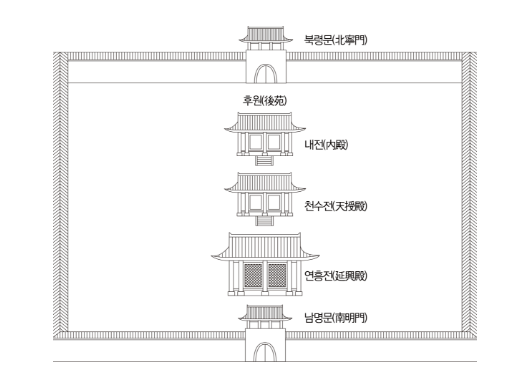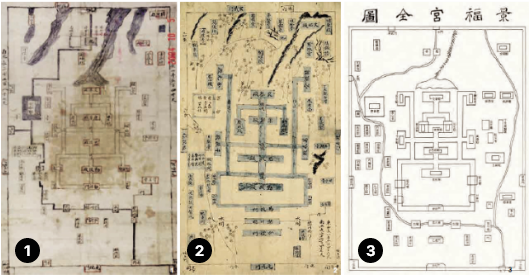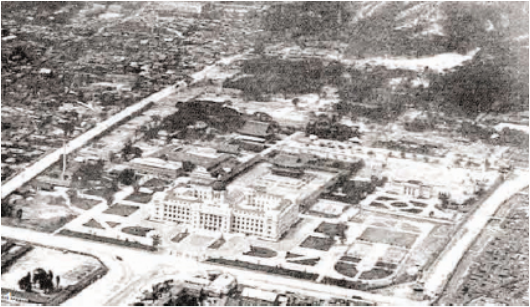The area surrounding Cheong Wa Dae was first recorded in historical documents during the reign of King Sukjong of Goryeo in 1104.
Goryeo had designated Kaegyeong (present-day Kaesong in North Korea), Seogyeong (Pyongyang), and Donggyeong (Gyeongju) as the three capitals of the nation. However, during Sukjong's reign, a secondary palace, presumed to be in the area now known as Cheong Wa Dae, replaced Donggyeong as the southern capital, Namgyeong, meaning 'the southern Seoul.'

Restored map of presumed location of royal palace in Namgyeong

- Map of Gyeongbokgung Palace『View of Gyeongbokgung Palace through Photos』 2006, 75th page, National Heritage Administration
- Map of Gyeongbokgung PalaceAfter the 43rd Year of King Yeongjo's reign (1767), Property of Seoul Museum of History
- Complete Map of Gyeongbokgung PalaceAfter the 43rd Year of King Yeongjo's reign (1767), Property of Samsung Museum of Publishing

Site of a secondary palaceCompletion of Gyeongbokgung Palace
The area around Cheong Wa Dae reappears in historical records as Lee Seong-gye founded the Joseon dynasty and deliberated on relocating the capital. In 1394, officials reported that the secondary palace site from King Sukjong’s era was too cramped for a new palace and suggested building further south. That year in December, construction began, and Gyeongbokgung Palace was completed in September of the following year. Until the Japanese invasions of Korea (Imjin War), Joseon kings mainly resided at Gyeongbokgung, and the area around present-day Cheong Wa Dae hosted irregular meetings where the king and officials pledged loyalty and unity to the heavens. The royal garden of Gyeongbokgung, mentioned in the “Annals” as "Geumwon" or "Sangwon," was located within the northern wall of Gyeongbokgung, close to today’s Cheong Wa Dae.
Gyeongmudae
In 1592, the Imjin War devastated Gyeongbokgung, leaving it in ruins for about 270 years until its reconstruction in 1865, the second year of King Gojong. Various structures were erected around the current Cheong Wa Dae area, including Yungmundang, a former examination hall, and Yungmudang, a military training facility, along with Oungak, Okryeonjeong, and Gyeongnongjae, starting in 1868. From 1869, the area around Yungmundang and Yungmudang began to be called Gyeongmudae. After the Japanese colonial period, in 1929, the Governor-General of Korea commemorated the 20th anniversary of Japanese rule by hosting the Korea Exposition at the sites of Gyeongbokgung Palace and Gyeongmudae, leading to the demolition of most buildings. Following the conclusion of the 1929 Korea Exposition, the area remained a vast open field for some time. In 1939, the Japanese constructed the residence for the Governor-General of Korea on this site.
From Gyeongmudae to Cheong Wa Dae
After liberation in 1945, the building that served as the Governor-General's residence was used as the residence for the U.S. military government commander, and following the establishment of the Republic of Korea in 1948, it was handed over to the government. President Syngman Rhee and his spouse moved from Ihwajang to Gyeongmudae, using the first floor as the presidential office and the second floor as the presidential residence. This site, including the Main Building, was called Gyeongmudae according to the old name and became the center of the nation's administration. In 1960, President Yun Posun, considering the public’s negative perception of Gyeongmudae, renamed it Cheong Wa Dae in 1961, taking inspiration from the blue tiles on the Main Building's roof.
Full Opening to the Public
During President Park Chung-hee's tenure, the economy grew alongside Cheong Wa Dae’s secretarial functions and infrastructure expansion. Subsequent renovations and extensions, including the construction of Yeongbingwan and Sangchunjae, brought significant changes to the Cheong Wa Dae compound. Under President Roh Tae-woo, a decision was made to build a new Cheong Wa Dae befitting the country’s stature and democratic era, resulting in the construction of the current Presidential Residence and Chunchugwan in 1990 and the Main Building in 1991. In 1993, under President Kim Young-sam, the Old Main Building, built during the Japanese occupation, was demolished. Subsequently, Presidents Kim Dae-jung, Roh Moo-hyun, Lee Myung-bak, Park Geun-hye, and Moon Jae-in performed their duties from the Main Building. In 2022, with President Yoon Suk-yeol's office and residence relocation, Cheong Wa Dae was fully opened to the public.



